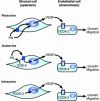Is cyclooxygenase-2 the alpha and the omega in cancer?
- PMID: 10841506
- PMCID: PMC300865
- DOI: 10.1172/JCI10241
Is cyclooxygenase-2 the alpha and the omega in cancer?
Figures


Comment on
-
Host cyclooxygenase-2 modulates carcinoma growth.J Clin Invest. 2000 Jun;105(11):1589-94. doi: 10.1172/JCI9621. J Clin Invest. 2000. PMID: 10841517 Free PMC article.
References
-
- Tsujii M, et al. Cyclooxygenase regulates angiogenesis induced by colon cancer cells. Cell. 1998;93:705–716. - PubMed
-
- Sawaoka H, et al. Cyclooxygenase inhibitors suppress angiogenesis and reduce tumor growth in vivo. Lab Invest. 1999;79:1469–1477. - PubMed
-
- Jones MK, et al. Inhibition of angiogenesis by nonsteroidal anti-inflammatory drugs: insight into mechanisms and implications for cancer growth and ulcer healing. Nat Med. 1999;5:1418–1423. - PubMed
-
- Masferrer JL, et al. Antiangiogenic and antitumor activities of cyclooxygenase-2 inhibitors. Cancer Res. 2000;60:1306–1311. - PubMed
Publication types
MeSH terms
Substances
LinkOut - more resources
Full Text Sources
Research Materials

